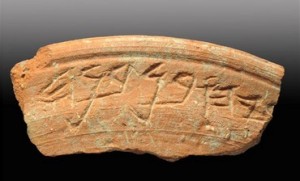
Ceramic bowl with a partially-preserved inscription. Photo: Clara Amit, Israel Antiquities Authority
Thousands of fragments of pottery, candles, ceramics and figurines dating to the end of the First Temple were discovered during archaeological excavations in the City of David in Jerusalem, located on a narrow spur south of the Temple Mount, surrounded on all sides by valleys, near the Gihon Spring and the Arab village of the Silwan.
The findings were discovered during excavations conducted by the Israel Antiquities Authority, the most important of which being a ceramic bowl with a partially-preserved Hebrew inscription, possibly containing the name of a Biblical figure.
Archaeologists Dr. Joe Uziel and Nahshon Zanton stated in a press release Sunday that the engraved letters date back to eighth century earthenware, and that the bowl can be traced to the time of the destruction of Jerusalem under King of Judah Zedekiah, around 586 BC.
They believe the inscription may be an address, and possibly contained an offering, given by the person whose name was inscribed on the vessel, they said.
The writing on the bowl has been identified as ancient Hebrew script, although the first letter is missing and the bowl is only partially preserved.
The text fragment on the fragment roughly transliterates without vowels into English characters as “ryhu bn bnh.” This is similar to the name of Zechariah son of Benaiah, the father of the prophet Jahaziel, whose name appears in 2 Chronicles 20:14 when Jahaziel spoke prophecy to King Jehoshaphat before the king went off to war.
It won’t be long before the button is made into a suit.

A piece of eigth century BCE earthenware with an inscription which can be traced to the time of the destruction in 586 BCE???
This is not an an archaeological report. Is it an effort to raise political support? For what? –excavating in the occupied zone of Jerusalem?
Thomas
Thomas L. Thompson
Professor emeritus, University of Copenhagen
LikeLike
archaeology for ideology
LikeLike
Keep denying.
LikeLike
the maxis will have to bring more than speculation and supposition
LikeLike
Can anyone explain to me the IAA sentence: “engraved letters date back to eighth century earthenware” ?
In any event, IF the first partly visible letter is indeed a Resh, than the personal name can be reconstruct in several ways: “‘Uriyahu”, “Zekaryahu”, “Neriyahu”, “‘Azaryahu”, but if the first visible letter is an ‘Ayin than there are many more possibilities to be considered. Therefore to jump immediately to 2 Chronicles 20:14 is a high jump (or a high jump).
LikeLike
no more than i can explain why the report says the inscription is 8th c. AND that it dates to around 586…
LikeLike